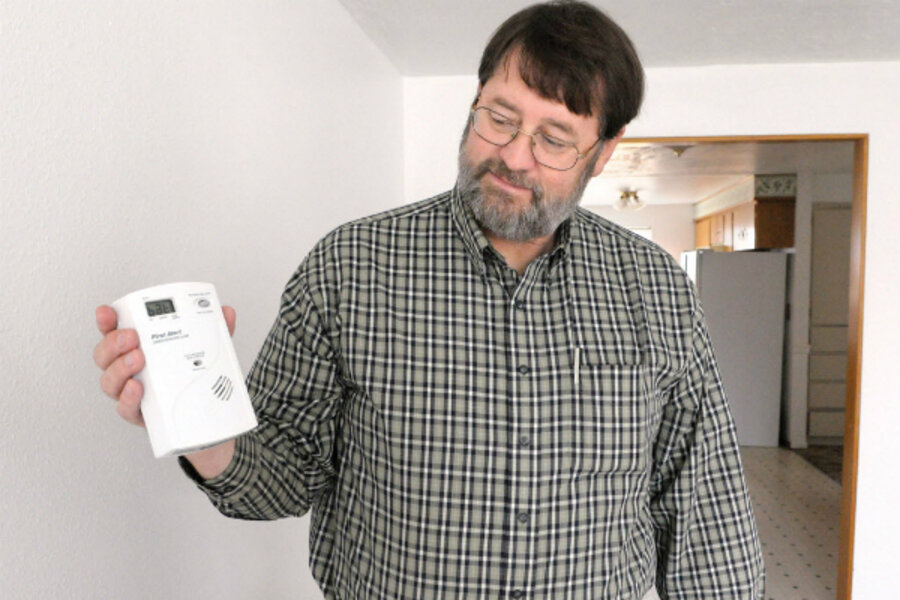Deep freeze and family safety: Watch the carbon monoxide levels
Loading...
| Norfolk, Va.
A little animal, the sharp drop in temperatures – below freezing here in Norfolk last week – and the recent flu epidemic formed a dangerous conspiracy of miscommunication in our household this week: the nearly missed signs of carbon monoxide – CO -- poisoning in a house buttoned tight for the winter.
We have a battery operated CO detector. But being penny-wise and not buying batteries as often as we should, it wasn’t working while a toxic CO level built in our home after some wildlife chose our chimney (which vents the gas furnace and hot water heater) as a potential nest.
For two weeks my husband, three sons, and I suffered from the blahs and flu-like symptoms which we chalked-up to seasonal illness. When we felt better after being away from the house it was assumed that the illness had subsided or home remedies had worked.
Our son Ian, 17, came home early from high school exam day and said the house “smelled like gas” – like propane, he added. Virginia Natural Gas puts in an additive “mercaptan” that makes the normally odorless gas smell like rotten eggs; which is different from the “propane smell,” and we never use propane indoors. So I told him not to worry. When he insisted, I gave the “Don’t sass your mother” warning.
It was fairly rare for Ian to come back to me a few minutes later looking mulish and actually demand I call the gas company – so unusual and alarming that I relented and called.
I was told not to put my cordless phone handset back on the receiver or use the computer to prevent them from causing a spark. I was told to check on the flame in the furnace because, according to the emergency operator at VA Natural Gas, “A gas flame should burn bright blue. A yellow or orange flame could indicate improper combustion or venting.”
Virginia Natural Gas (VNG) offers a checklist for detecting potential signs of carbon monoxide buildup and poisoning symptoms and we had them all. The buildup clues are: stuffy or stale air, very high humidity, fallen soot from the chimney or draft hood, and a hot draft coming from the draft hood. The poisoning symptoms were very similar to those being pounded into us by all the stories about the flu epidemic.
According to the VGN technician who assessed our home, the CO level should have been no higher than 9 parts-per-million by the handheld meter that he brought. Our home was at 240 PPM and climbing fast. “At levels over 9 PPM, CO begins to adversely affect your health if you persist in breathing it for over eight hours," according to eHow’s David Scott.
Today everyone is fine. We opened all the windows, shut down appliances, got the people, cats, and dog outdoors and had a neighbor who has a heating business make an emergency visit. He found the chimney blocked, saying it was birds or squirrels trying to keep warm by filling the chimney with twigs and leaves in hopes of building a nest.
I talked to VGN spokesman Duane Bourne, who said our situation is not uncommon. “These [carbon monoxide] leaks occur most often during the winter months, when an improperly vented furnace is turned on for the first time and when a furnace runs more frequently during colder temperatures like what you have been experiencing."
The debris filled a 5-gallon bucket, and then all was right with the world again. I bought a slightly more expensive detector that has both batteries as well as a plug for sockets. Sure, times are tough, but our family is priceless.
I wish a little bird had told me what to look for a month ago, instead of creating distress in our nest. I am putting up netting around the chimney cap and two new birdhouses down in the yard.
The Christian Science Monitor has assembled a diverse group of the best family and parenting bloggers out there. Our contributing and guest bloggers are not employed or directed by the Monitor, and the views expressed are the bloggers' own, as is responsibility for the content of their blogs.








